Achieving Competitive Success: Resources and Capabilities Analysis
VerifiedAdded on 2023/06/09
|9
|2117
|368
Essay
AI Summary
This essay provides a comprehensive analysis of competitive advantages in the business domain. It identifies five key resources and capabilities essential for achieving long-term success: people, strategic assets, product differentiation, a strong financial position, and technological advantage. The essay emphasizes the significance of human capital, including innovative and hardworking employees, and the importance of strategic assets such as trademarks, copyrights, and patents. It explores the value of product differentiation, highlighting various methods to distinguish offerings from competitors. The essay also underscores the critical role of a robust financial standing and the adoption of advanced technology. Furthermore, it discusses methods for developing sustainable competitive advantages, including employee training, the creation of a sustainable business model, and a deep understanding of organizational strengths and core competencies. The conclusion stresses the need for businesses to possess at least two to three competitive resources to ensure sustainable success.
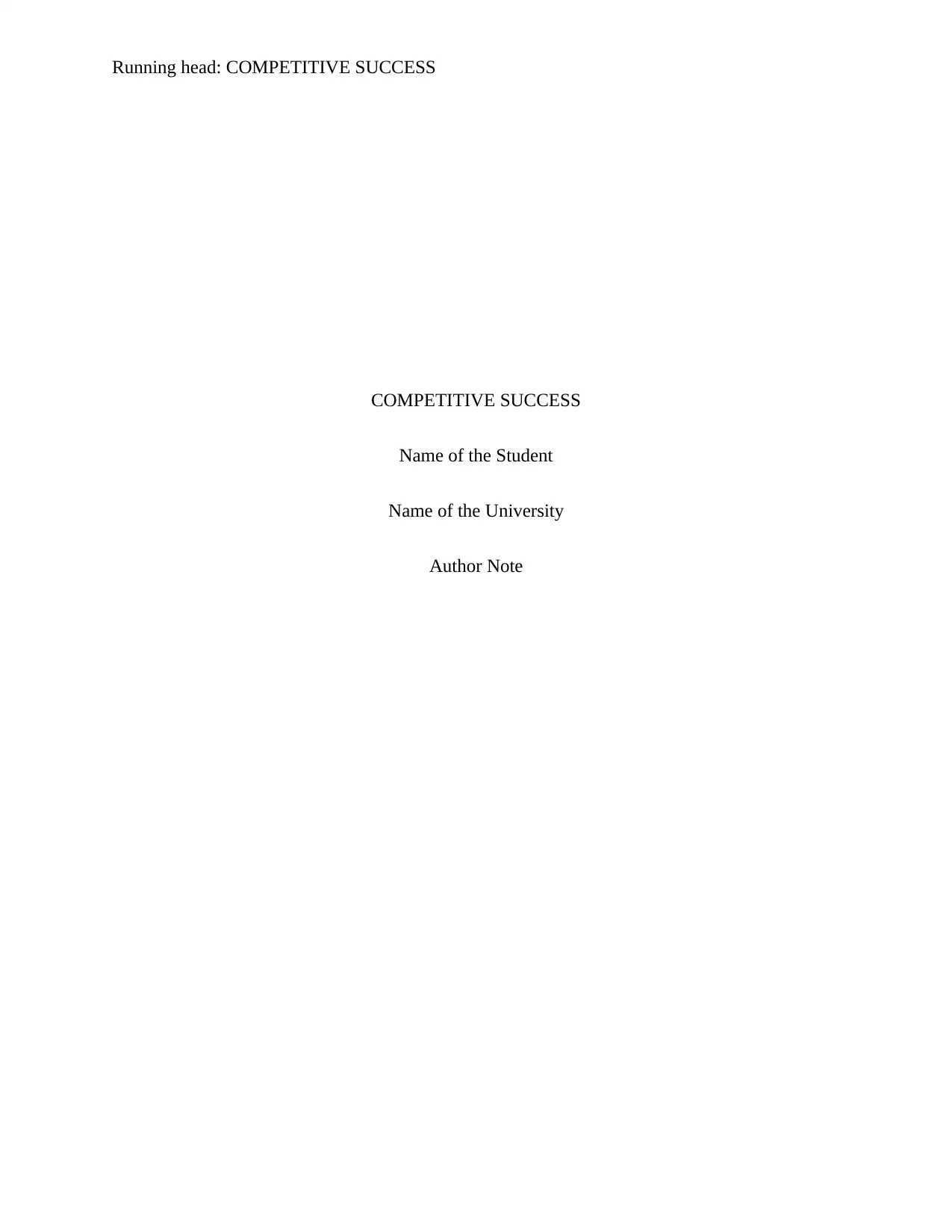
Running head: COMPETITIVE SUCCESS
COMPETITIVE SUCCESS
Name of the Student
Name of the University
Author Note
COMPETITIVE SUCCESS
Name of the Student
Name of the University
Author Note
Paraphrase This Document
Need a fresh take? Get an instant paraphrase of this document with our AI Paraphraser
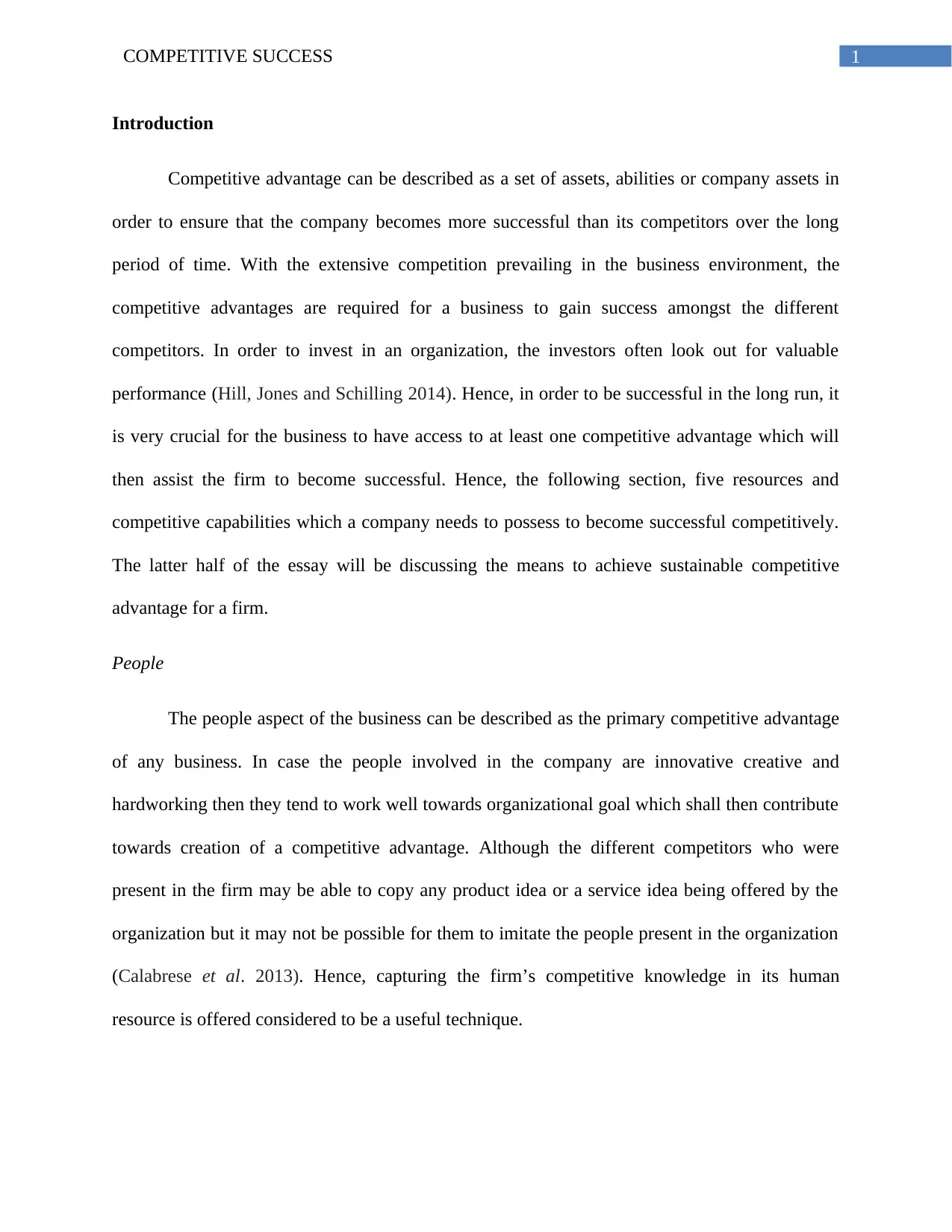
1COMPETITIVE SUCCESS
Introduction
Competitive advantage can be described as a set of assets, abilities or company assets in
order to ensure that the company becomes more successful than its competitors over the long
period of time. With the extensive competition prevailing in the business environment, the
competitive advantages are required for a business to gain success amongst the different
competitors. In order to invest in an organization, the investors often look out for valuable
performance (Hill, Jones and Schilling 2014). Hence, in order to be successful in the long run, it
is very crucial for the business to have access to at least one competitive advantage which will
then assist the firm to become successful. Hence, the following section, five resources and
competitive capabilities which a company needs to possess to become successful competitively.
The latter half of the essay will be discussing the means to achieve sustainable competitive
advantage for a firm.
People
The people aspect of the business can be described as the primary competitive advantage
of any business. In case the people involved in the company are innovative creative and
hardworking then they tend to work well towards organizational goal which shall then contribute
towards creation of a competitive advantage. Although the different competitors who were
present in the firm may be able to copy any product idea or a service idea being offered by the
organization but it may not be possible for them to imitate the people present in the organization
(Calabrese et al. 2013). Hence, capturing the firm’s competitive knowledge in its human
resource is offered considered to be a useful technique.
Introduction
Competitive advantage can be described as a set of assets, abilities or company assets in
order to ensure that the company becomes more successful than its competitors over the long
period of time. With the extensive competition prevailing in the business environment, the
competitive advantages are required for a business to gain success amongst the different
competitors. In order to invest in an organization, the investors often look out for valuable
performance (Hill, Jones and Schilling 2014). Hence, in order to be successful in the long run, it
is very crucial for the business to have access to at least one competitive advantage which will
then assist the firm to become successful. Hence, the following section, five resources and
competitive capabilities which a company needs to possess to become successful competitively.
The latter half of the essay will be discussing the means to achieve sustainable competitive
advantage for a firm.
People
The people aspect of the business can be described as the primary competitive advantage
of any business. In case the people involved in the company are innovative creative and
hardworking then they tend to work well towards organizational goal which shall then contribute
towards creation of a competitive advantage. Although the different competitors who were
present in the firm may be able to copy any product idea or a service idea being offered by the
organization but it may not be possible for them to imitate the people present in the organization
(Calabrese et al. 2013). Hence, capturing the firm’s competitive knowledge in its human
resource is offered considered to be a useful technique.
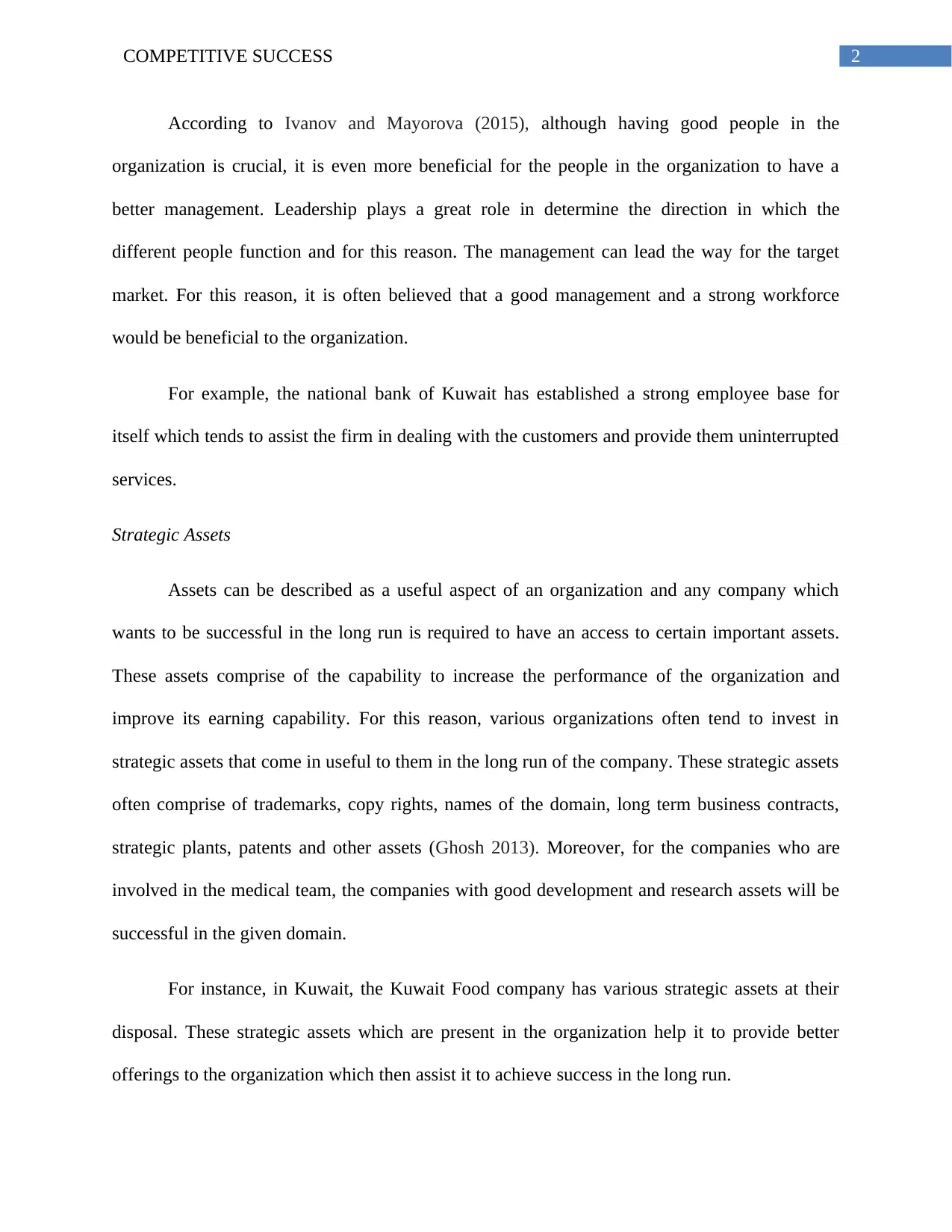
2COMPETITIVE SUCCESS
According to Ivanov and Mayorova (2015), although having good people in the
organization is crucial, it is even more beneficial for the people in the organization to have a
better management. Leadership plays a great role in determine the direction in which the
different people function and for this reason. The management can lead the way for the target
market. For this reason, it is often believed that a good management and a strong workforce
would be beneficial to the organization.
For example, the national bank of Kuwait has established a strong employee base for
itself which tends to assist the firm in dealing with the customers and provide them uninterrupted
services.
Strategic Assets
Assets can be described as a useful aspect of an organization and any company which
wants to be successful in the long run is required to have an access to certain important assets.
These assets comprise of the capability to increase the performance of the organization and
improve its earning capability. For this reason, various organizations often tend to invest in
strategic assets that come in useful to them in the long run of the company. These strategic assets
often comprise of trademarks, copy rights, names of the domain, long term business contracts,
strategic plants, patents and other assets (Ghosh 2013). Moreover, for the companies who are
involved in the medical team, the companies with good development and research assets will be
successful in the given domain.
For instance, in Kuwait, the Kuwait Food company has various strategic assets at their
disposal. These strategic assets which are present in the organization help it to provide better
offerings to the organization which then assist it to achieve success in the long run.
According to Ivanov and Mayorova (2015), although having good people in the
organization is crucial, it is even more beneficial for the people in the organization to have a
better management. Leadership plays a great role in determine the direction in which the
different people function and for this reason. The management can lead the way for the target
market. For this reason, it is often believed that a good management and a strong workforce
would be beneficial to the organization.
For example, the national bank of Kuwait has established a strong employee base for
itself which tends to assist the firm in dealing with the customers and provide them uninterrupted
services.
Strategic Assets
Assets can be described as a useful aspect of an organization and any company which
wants to be successful in the long run is required to have an access to certain important assets.
These assets comprise of the capability to increase the performance of the organization and
improve its earning capability. For this reason, various organizations often tend to invest in
strategic assets that come in useful to them in the long run of the company. These strategic assets
often comprise of trademarks, copy rights, names of the domain, long term business contracts,
strategic plants, patents and other assets (Ghosh 2013). Moreover, for the companies who are
involved in the medical team, the companies with good development and research assets will be
successful in the given domain.
For instance, in Kuwait, the Kuwait Food company has various strategic assets at their
disposal. These strategic assets which are present in the organization help it to provide better
offerings to the organization which then assist it to achieve success in the long run.
⊘ This is a preview!⊘
Do you want full access?
Subscribe today to unlock all pages.

Trusted by 1+ million students worldwide
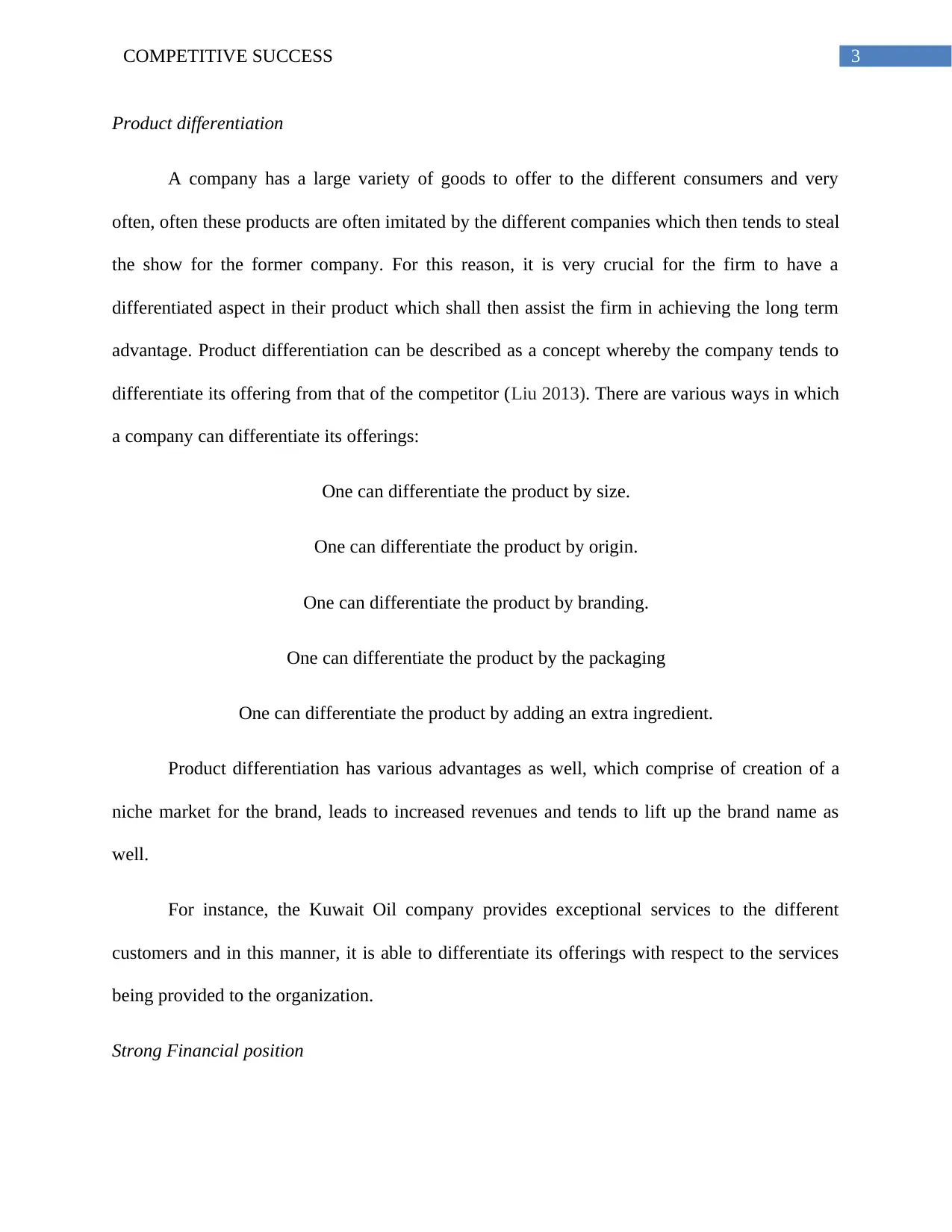
3COMPETITIVE SUCCESS
Product differentiation
A company has a large variety of goods to offer to the different consumers and very
often, often these products are often imitated by the different companies which then tends to steal
the show for the former company. For this reason, it is very crucial for the firm to have a
differentiated aspect in their product which shall then assist the firm in achieving the long term
advantage. Product differentiation can be described as a concept whereby the company tends to
differentiate its offering from that of the competitor (Liu 2013). There are various ways in which
a company can differentiate its offerings:
One can differentiate the product by size.
One can differentiate the product by origin.
One can differentiate the product by branding.
One can differentiate the product by the packaging
One can differentiate the product by adding an extra ingredient.
Product differentiation has various advantages as well, which comprise of creation of a
niche market for the brand, leads to increased revenues and tends to lift up the brand name as
well.
For instance, the Kuwait Oil company provides exceptional services to the different
customers and in this manner, it is able to differentiate its offerings with respect to the services
being provided to the organization.
Strong Financial position
Product differentiation
A company has a large variety of goods to offer to the different consumers and very
often, often these products are often imitated by the different companies which then tends to steal
the show for the former company. For this reason, it is very crucial for the firm to have a
differentiated aspect in their product which shall then assist the firm in achieving the long term
advantage. Product differentiation can be described as a concept whereby the company tends to
differentiate its offering from that of the competitor (Liu 2013). There are various ways in which
a company can differentiate its offerings:
One can differentiate the product by size.
One can differentiate the product by origin.
One can differentiate the product by branding.
One can differentiate the product by the packaging
One can differentiate the product by adding an extra ingredient.
Product differentiation has various advantages as well, which comprise of creation of a
niche market for the brand, leads to increased revenues and tends to lift up the brand name as
well.
For instance, the Kuwait Oil company provides exceptional services to the different
customers and in this manner, it is able to differentiate its offerings with respect to the services
being provided to the organization.
Strong Financial position
Paraphrase This Document
Need a fresh take? Get an instant paraphrase of this document with our AI Paraphraser
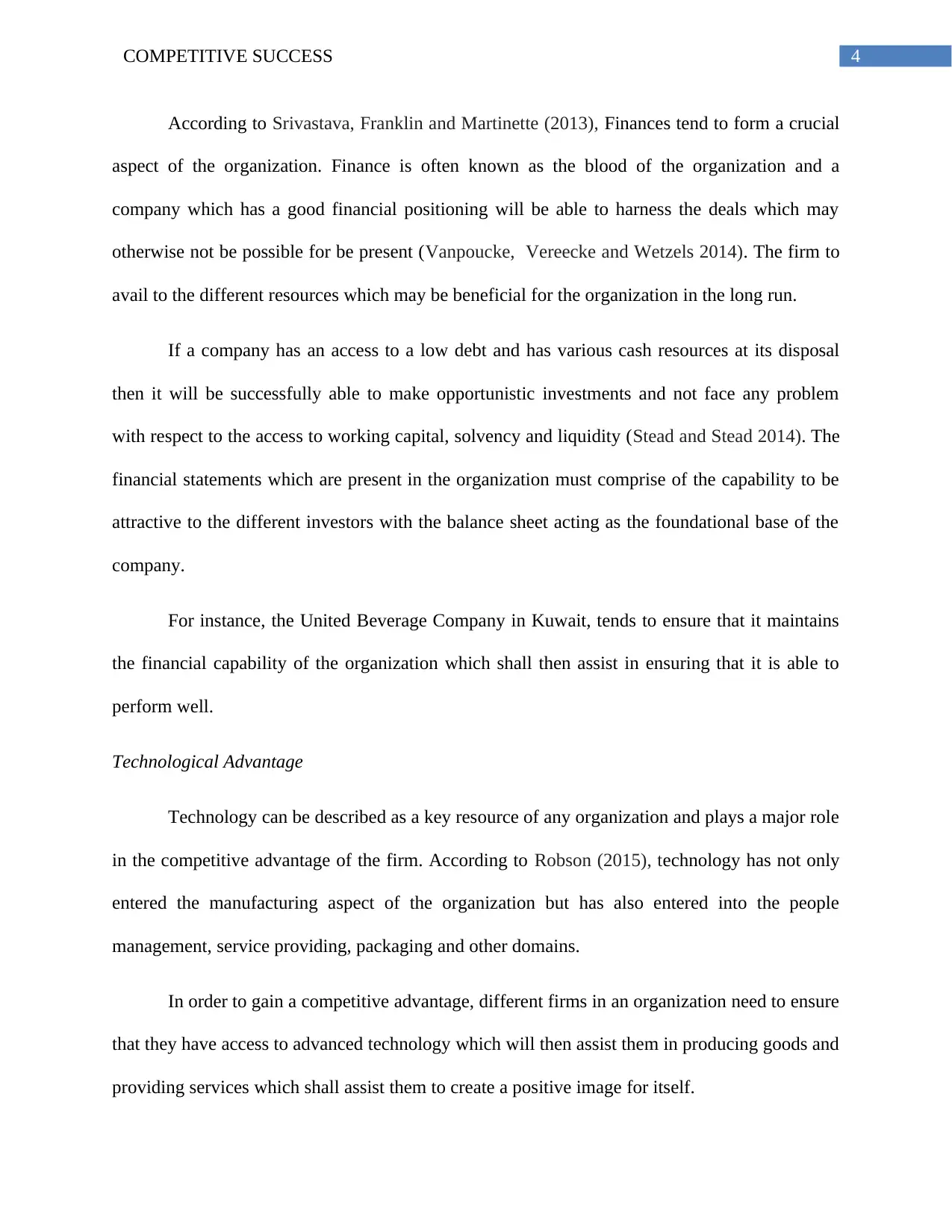
4COMPETITIVE SUCCESS
According to Srivastava, Franklin and Martinette (2013), Finances tend to form a crucial
aspect of the organization. Finance is often known as the blood of the organization and a
company which has a good financial positioning will be able to harness the deals which may
otherwise not be possible for be present (Vanpoucke, Vereecke and Wetzels 2014). The firm to
avail to the different resources which may be beneficial for the organization in the long run.
If a company has an access to a low debt and has various cash resources at its disposal
then it will be successfully able to make opportunistic investments and not face any problem
with respect to the access to working capital, solvency and liquidity (Stead and Stead 2014). The
financial statements which are present in the organization must comprise of the capability to be
attractive to the different investors with the balance sheet acting as the foundational base of the
company.
For instance, the United Beverage Company in Kuwait, tends to ensure that it maintains
the financial capability of the organization which shall then assist in ensuring that it is able to
perform well.
Technological Advantage
Technology can be described as a key resource of any organization and plays a major role
in the competitive advantage of the firm. According to Robson (2015), technology has not only
entered the manufacturing aspect of the organization but has also entered into the people
management, service providing, packaging and other domains.
In order to gain a competitive advantage, different firms in an organization need to ensure
that they have access to advanced technology which will then assist them in producing goods and
providing services which shall assist them to create a positive image for itself.
According to Srivastava, Franklin and Martinette (2013), Finances tend to form a crucial
aspect of the organization. Finance is often known as the blood of the organization and a
company which has a good financial positioning will be able to harness the deals which may
otherwise not be possible for be present (Vanpoucke, Vereecke and Wetzels 2014). The firm to
avail to the different resources which may be beneficial for the organization in the long run.
If a company has an access to a low debt and has various cash resources at its disposal
then it will be successfully able to make opportunistic investments and not face any problem
with respect to the access to working capital, solvency and liquidity (Stead and Stead 2014). The
financial statements which are present in the organization must comprise of the capability to be
attractive to the different investors with the balance sheet acting as the foundational base of the
company.
For instance, the United Beverage Company in Kuwait, tends to ensure that it maintains
the financial capability of the organization which shall then assist in ensuring that it is able to
perform well.
Technological Advantage
Technology can be described as a key resource of any organization and plays a major role
in the competitive advantage of the firm. According to Robson (2015), technology has not only
entered the manufacturing aspect of the organization but has also entered into the people
management, service providing, packaging and other domains.
In order to gain a competitive advantage, different firms in an organization need to ensure
that they have access to advanced technology which will then assist them in producing goods and
providing services which shall assist them to create a positive image for itself.
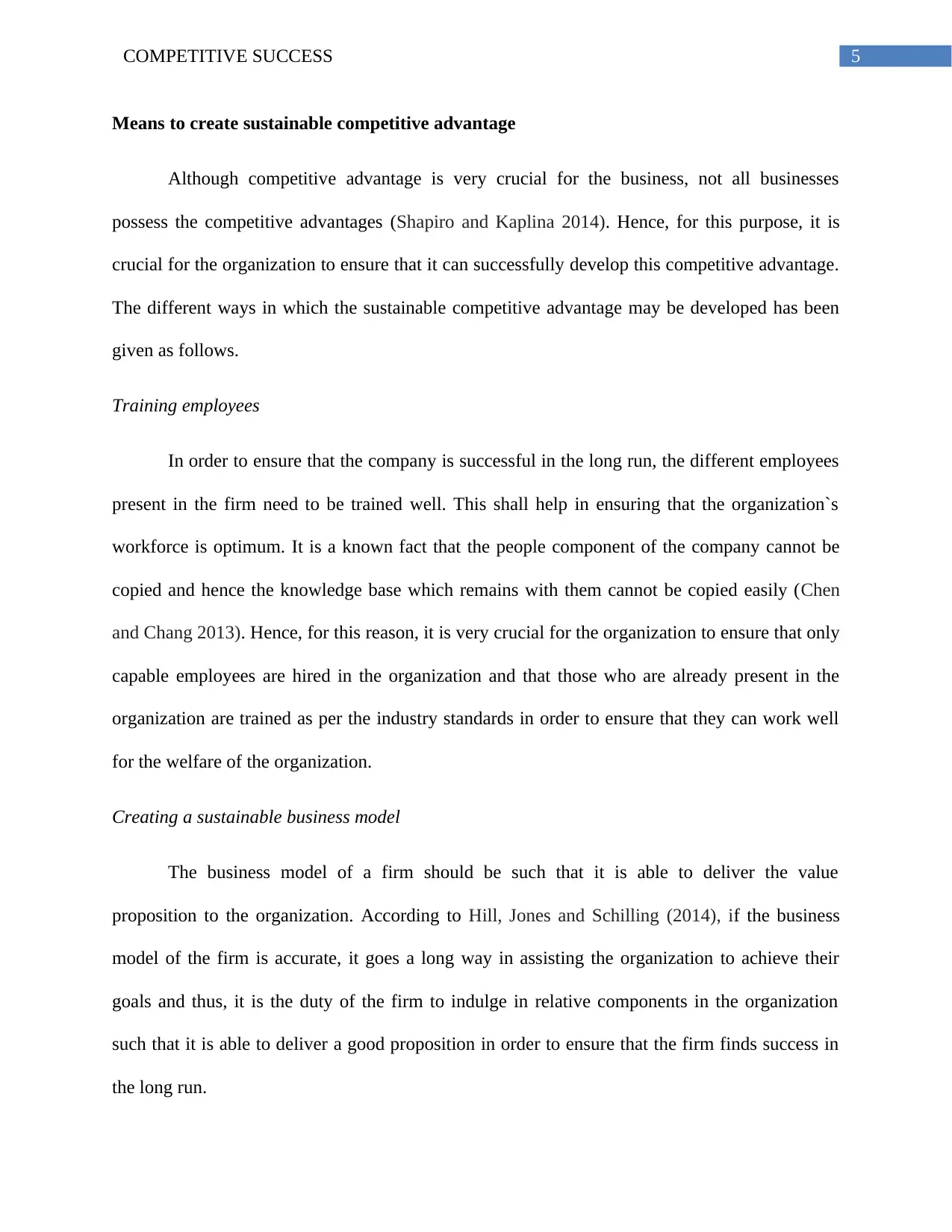
5COMPETITIVE SUCCESS
Means to create sustainable competitive advantage
Although competitive advantage is very crucial for the business, not all businesses
possess the competitive advantages (Shapiro and Kaplina 2014). Hence, for this purpose, it is
crucial for the organization to ensure that it can successfully develop this competitive advantage.
The different ways in which the sustainable competitive advantage may be developed has been
given as follows.
Training employees
In order to ensure that the company is successful in the long run, the different employees
present in the firm need to be trained well. This shall help in ensuring that the organization`s
workforce is optimum. It is a known fact that the people component of the company cannot be
copied and hence the knowledge base which remains with them cannot be copied easily (Chen
and Chang 2013). Hence, for this reason, it is very crucial for the organization to ensure that only
capable employees are hired in the organization and that those who are already present in the
organization are trained as per the industry standards in order to ensure that they can work well
for the welfare of the organization.
Creating a sustainable business model
The business model of a firm should be such that it is able to deliver the value
proposition to the organization. According to Hill, Jones and Schilling (2014), if the business
model of the firm is accurate, it goes a long way in assisting the organization to achieve their
goals and thus, it is the duty of the firm to indulge in relative components in the organization
such that it is able to deliver a good proposition in order to ensure that the firm finds success in
the long run.
Means to create sustainable competitive advantage
Although competitive advantage is very crucial for the business, not all businesses
possess the competitive advantages (Shapiro and Kaplina 2014). Hence, for this purpose, it is
crucial for the organization to ensure that it can successfully develop this competitive advantage.
The different ways in which the sustainable competitive advantage may be developed has been
given as follows.
Training employees
In order to ensure that the company is successful in the long run, the different employees
present in the firm need to be trained well. This shall help in ensuring that the organization`s
workforce is optimum. It is a known fact that the people component of the company cannot be
copied and hence the knowledge base which remains with them cannot be copied easily (Chen
and Chang 2013). Hence, for this reason, it is very crucial for the organization to ensure that only
capable employees are hired in the organization and that those who are already present in the
organization are trained as per the industry standards in order to ensure that they can work well
for the welfare of the organization.
Creating a sustainable business model
The business model of a firm should be such that it is able to deliver the value
proposition to the organization. According to Hill, Jones and Schilling (2014), if the business
model of the firm is accurate, it goes a long way in assisting the organization to achieve their
goals and thus, it is the duty of the firm to indulge in relative components in the organization
such that it is able to deliver a good proposition in order to ensure that the firm finds success in
the long run.
⊘ This is a preview!⊘
Do you want full access?
Subscribe today to unlock all pages.

Trusted by 1+ million students worldwide
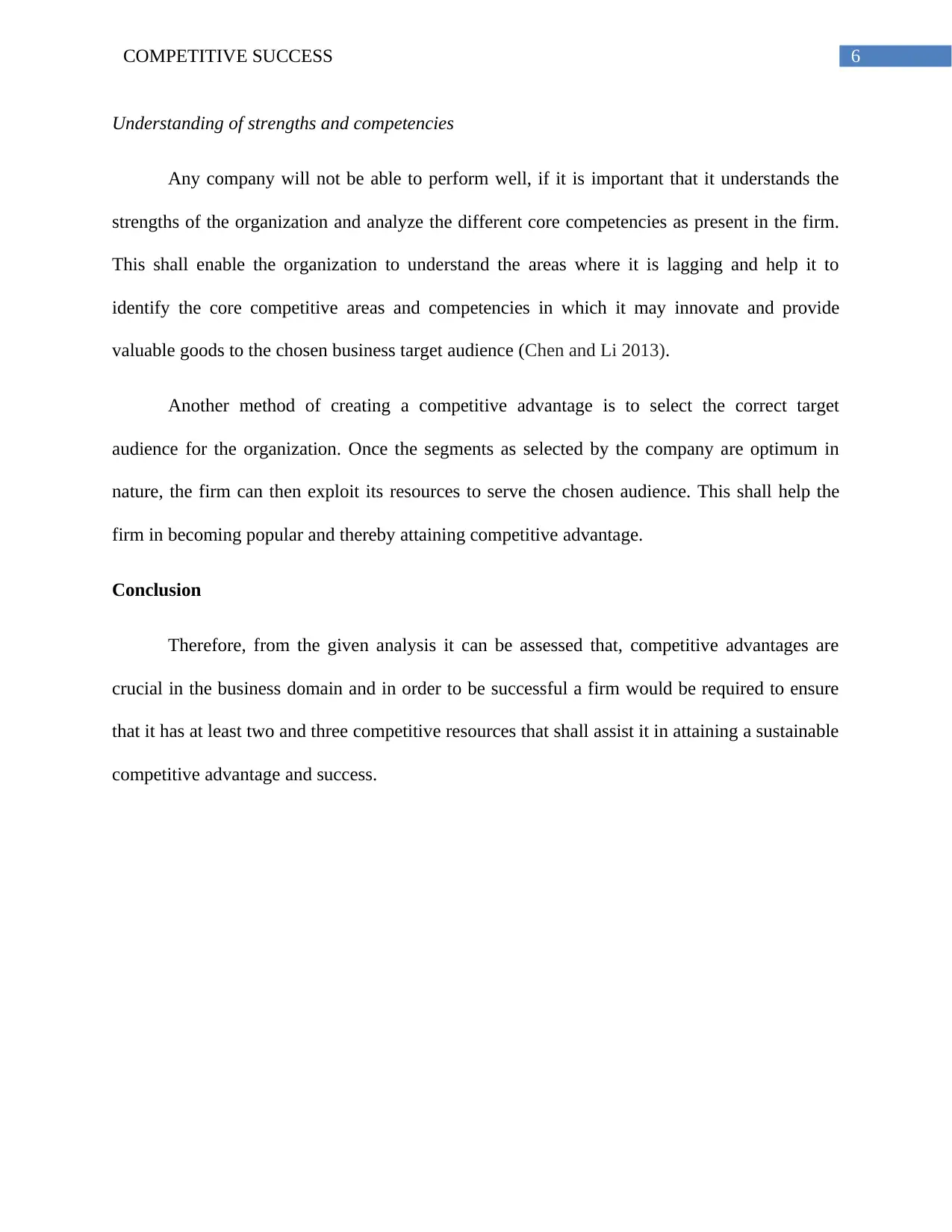
6COMPETITIVE SUCCESS
Understanding of strengths and competencies
Any company will not be able to perform well, if it is important that it understands the
strengths of the organization and analyze the different core competencies as present in the firm.
This shall enable the organization to understand the areas where it is lagging and help it to
identify the core competitive areas and competencies in which it may innovate and provide
valuable goods to the chosen business target audience (Chen and Li 2013).
Another method of creating a competitive advantage is to select the correct target
audience for the organization. Once the segments as selected by the company are optimum in
nature, the firm can then exploit its resources to serve the chosen audience. This shall help the
firm in becoming popular and thereby attaining competitive advantage.
Conclusion
Therefore, from the given analysis it can be assessed that, competitive advantages are
crucial in the business domain and in order to be successful a firm would be required to ensure
that it has at least two and three competitive resources that shall assist it in attaining a sustainable
competitive advantage and success.
Understanding of strengths and competencies
Any company will not be able to perform well, if it is important that it understands the
strengths of the organization and analyze the different core competencies as present in the firm.
This shall enable the organization to understand the areas where it is lagging and help it to
identify the core competitive areas and competencies in which it may innovate and provide
valuable goods to the chosen business target audience (Chen and Li 2013).
Another method of creating a competitive advantage is to select the correct target
audience for the organization. Once the segments as selected by the company are optimum in
nature, the firm can then exploit its resources to serve the chosen audience. This shall help the
firm in becoming popular and thereby attaining competitive advantage.
Conclusion
Therefore, from the given analysis it can be assessed that, competitive advantages are
crucial in the business domain and in order to be successful a firm would be required to ensure
that it has at least two and three competitive resources that shall assist it in attaining a sustainable
competitive advantage and success.
Paraphrase This Document
Need a fresh take? Get an instant paraphrase of this document with our AI Paraphraser
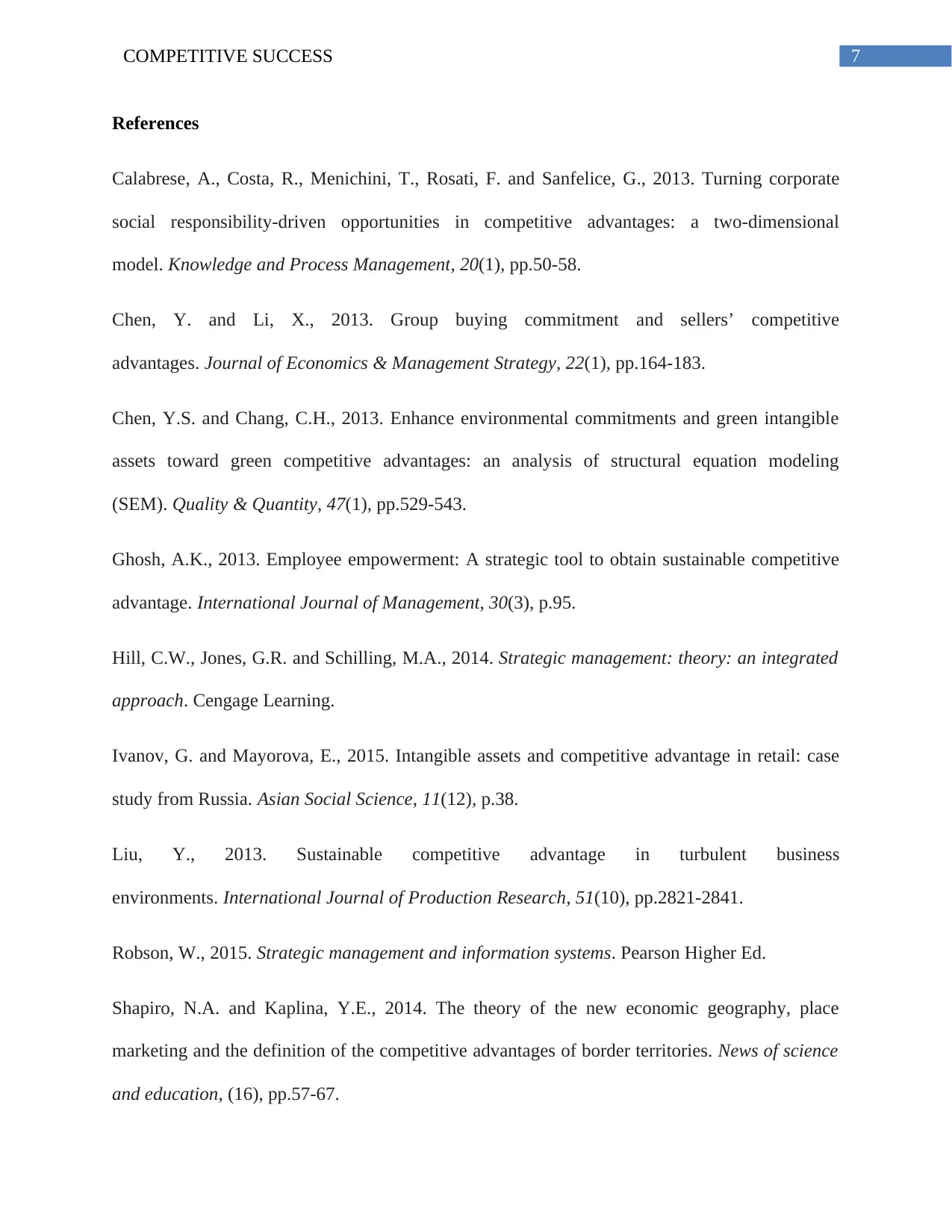
7COMPETITIVE SUCCESS
References
Calabrese, A., Costa, R., Menichini, T., Rosati, F. and Sanfelice, G., 2013. Turning corporate
social responsibility‐driven opportunities in competitive advantages: a two‐dimensional
model. Knowledge and Process Management, 20(1), pp.50-58.
Chen, Y. and Li, X., 2013. Group buying commitment and sellers’ competitive
advantages. Journal of Economics & Management Strategy, 22(1), pp.164-183.
Chen, Y.S. and Chang, C.H., 2013. Enhance environmental commitments and green intangible
assets toward green competitive advantages: an analysis of structural equation modeling
(SEM). Quality & Quantity, 47(1), pp.529-543.
Ghosh, A.K., 2013. Employee empowerment: A strategic tool to obtain sustainable competitive
advantage. International Journal of Management, 30(3), p.95.
Hill, C.W., Jones, G.R. and Schilling, M.A., 2014. Strategic management: theory: an integrated
approach. Cengage Learning.
Ivanov, G. and Mayorova, E., 2015. Intangible assets and competitive advantage in retail: case
study from Russia. Asian Social Science, 11(12), p.38.
Liu, Y., 2013. Sustainable competitive advantage in turbulent business
environments. International Journal of Production Research, 51(10), pp.2821-2841.
Robson, W., 2015. Strategic management and information systems. Pearson Higher Ed.
Shapiro, N.A. and Kaplina, Y.E., 2014. The theory of the new economic geography, place
marketing and the definition of the competitive advantages of border territories. News of science
and education, (16), pp.57-67.
References
Calabrese, A., Costa, R., Menichini, T., Rosati, F. and Sanfelice, G., 2013. Turning corporate
social responsibility‐driven opportunities in competitive advantages: a two‐dimensional
model. Knowledge and Process Management, 20(1), pp.50-58.
Chen, Y. and Li, X., 2013. Group buying commitment and sellers’ competitive
advantages. Journal of Economics & Management Strategy, 22(1), pp.164-183.
Chen, Y.S. and Chang, C.H., 2013. Enhance environmental commitments and green intangible
assets toward green competitive advantages: an analysis of structural equation modeling
(SEM). Quality & Quantity, 47(1), pp.529-543.
Ghosh, A.K., 2013. Employee empowerment: A strategic tool to obtain sustainable competitive
advantage. International Journal of Management, 30(3), p.95.
Hill, C.W., Jones, G.R. and Schilling, M.A., 2014. Strategic management: theory: an integrated
approach. Cengage Learning.
Ivanov, G. and Mayorova, E., 2015. Intangible assets and competitive advantage in retail: case
study from Russia. Asian Social Science, 11(12), p.38.
Liu, Y., 2013. Sustainable competitive advantage in turbulent business
environments. International Journal of Production Research, 51(10), pp.2821-2841.
Robson, W., 2015. Strategic management and information systems. Pearson Higher Ed.
Shapiro, N.A. and Kaplina, Y.E., 2014. The theory of the new economic geography, place
marketing and the definition of the competitive advantages of border territories. News of science
and education, (16), pp.57-67.
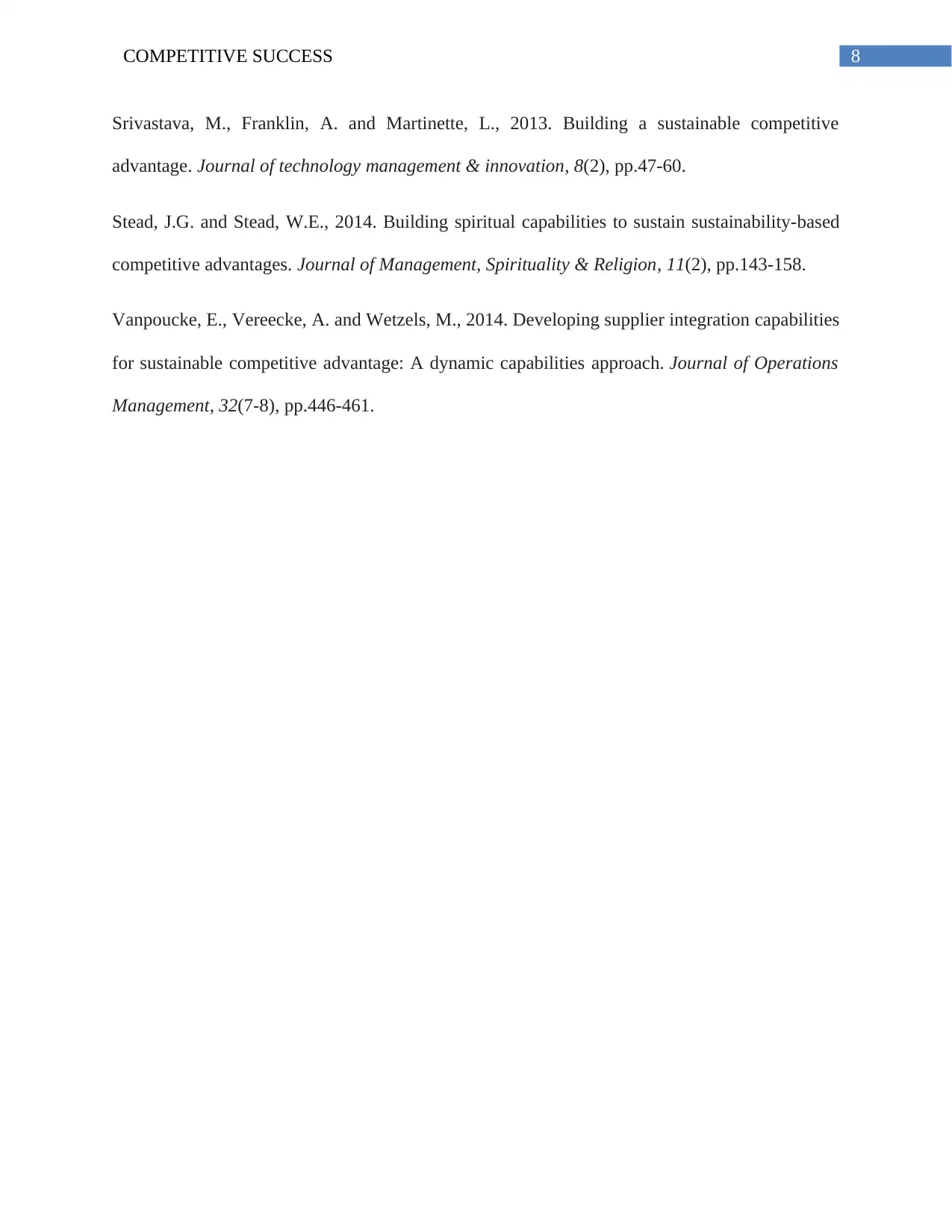
8COMPETITIVE SUCCESS
Srivastava, M., Franklin, A. and Martinette, L., 2013. Building a sustainable competitive
advantage. Journal of technology management & innovation, 8(2), pp.47-60.
Stead, J.G. and Stead, W.E., 2014. Building spiritual capabilities to sustain sustainability-based
competitive advantages. Journal of Management, Spirituality & Religion, 11(2), pp.143-158.
Vanpoucke, E., Vereecke, A. and Wetzels, M., 2014. Developing supplier integration capabilities
for sustainable competitive advantage: A dynamic capabilities approach. Journal of Operations
Management, 32(7-8), pp.446-461.
Srivastava, M., Franklin, A. and Martinette, L., 2013. Building a sustainable competitive
advantage. Journal of technology management & innovation, 8(2), pp.47-60.
Stead, J.G. and Stead, W.E., 2014. Building spiritual capabilities to sustain sustainability-based
competitive advantages. Journal of Management, Spirituality & Religion, 11(2), pp.143-158.
Vanpoucke, E., Vereecke, A. and Wetzels, M., 2014. Developing supplier integration capabilities
for sustainable competitive advantage: A dynamic capabilities approach. Journal of Operations
Management, 32(7-8), pp.446-461.
⊘ This is a preview!⊘
Do you want full access?
Subscribe today to unlock all pages.

Trusted by 1+ million students worldwide
1 out of 9
Related Documents
Your All-in-One AI-Powered Toolkit for Academic Success.
+13062052269
info@desklib.com
Available 24*7 on WhatsApp / Email
![[object Object]](/_next/static/media/star-bottom.7253800d.svg)
Unlock your academic potential
Copyright © 2020–2025 A2Z Services. All Rights Reserved. Developed and managed by ZUCOL.





